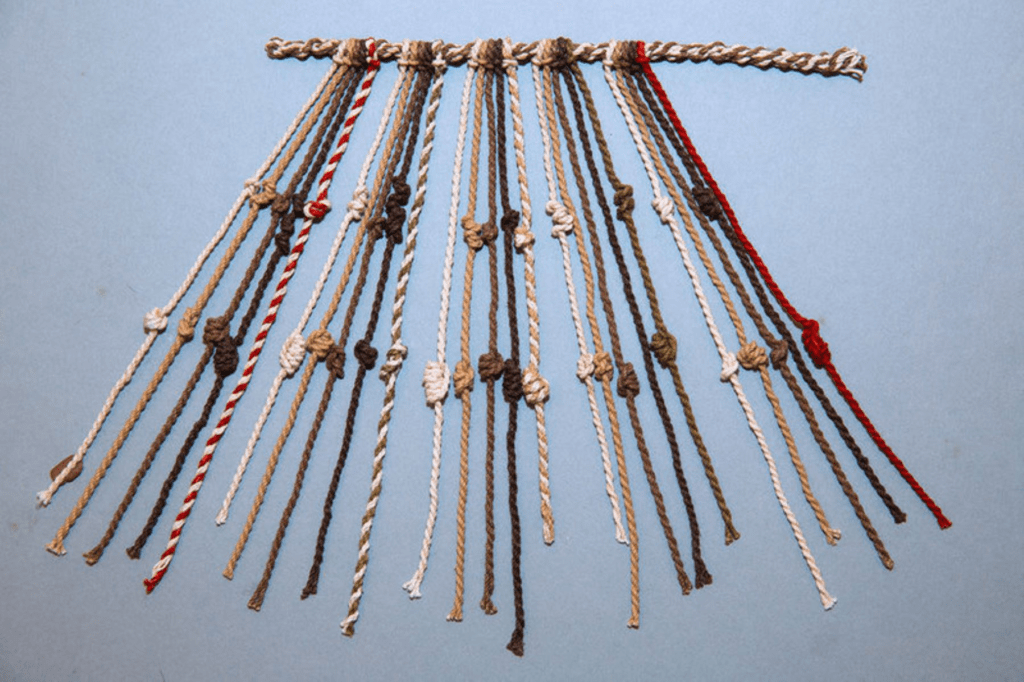In the heart of the Andes, the Incas developed one of humanity’s most mysterious systems of communication: the Qhipus, a complex arrangement of knotted cords used to record not only numbers but also stories, prayers, and cosmic relationships. Far from being a mere accounting device, the Qhipus functioned as a bridge between worlds—between spoken word and woven silence.

A Living System of Memory
The word Qhipu in Quechua means “knot.” Each cord—spun from alpaca or llama fiber, dyed in vibrant colors, and tied with deliberate intention—held multiple layers of meaning.

Far beyond numerical recordkeeping, the Qhipus encoded the texture of Andean life: genealogies, tributes, agricultural cycles, and ritual calendars.
As scholar Urton (2003) explains, “The Qhipus encoded information through a multi-dimensional binary system, where the tactile replaced the visual as the primary sense of reading.”
In this way, the Andean mind revealed its essence: knowledge was not linear but circular, relational, and alive.
Keepers of the Knots
Each Qhipukamayuq—the keeper of the knots—was both mathematician and storyteller, reading with the hands what the heart remembered. As anthropologist Salomon (2004) noted, “the Qhipus spoke through the hands,” preserving a form of memory rooted in touch, rhythm, and reciprocity.
These sacred record keepers embodied Yachay—the energy of sacred knowledge—serving as bridges between the visible and invisible worlds. They did not simply store data; they wove consciousness itself.
Threads of the Cosmos
In the Andean worldview, weaving and knowledge share a sacred bond. The act of tying a knot mirrors the way the cosmos itself is interlaced. The Qhipus was not merely a record—it was a reflection of Pachamama’s own design.

Each cord extended from a central thread, just as life unfolds from the ushnu, the cosmic center that sustains balance among the three worlds:
To untie a Qhipu was to touch the memory of the Andes, to feel how time, energy, and story intertwine.
Sacred Reciprocity: Ayni in Motion
Each knot and twist embodied Ayni—the sacred reciprocity that binds all existence. Just as threads connect fiber to fiber, they also bind community to cosmos, memory to matter, and spirit to form.
To “read” a Qhipu was to listen—not only to data, but to the pulse of creation itself. It was a form of communion between human intention and the living energy of Kawsay, the life force that flows through all beings.
Mathematics, Myth, and Mystery

Modern researchers such as Urton (2003) and Hyland (2016) suggest that Qhipus may represent a three-dimensional writing system, capable of encoding narrative, social, and historical information.
Yet even these discoveries only graze the surface.
For the Inca, knowledge was never merely analytical—it was ceremonial. The act of knotting threads mirrored the act of weaving life, uniting past, present, and future within the sacred continuum of Pacha.
Reviving the Ancestral Code
Today, Qhipus are being reawakened as spiritual instruments within Andean ceremonies. They are used to call upon ancestral memory, restore energetic harmony, and honor the living network of life. Each knot becomes a prayer—a coded intention offered to the Apus (mountain spirits) and to Mama Cocha, the oceanic womb of existence.
In this revival, we are reminded that knowledge does not live only in books or data. It also lives in threads, rivers, and rituals—where the sacred and the human are woven together into one living tapestry of consciousness.

References
- Allen, Catherine (1988). The Hold Life Has: Coca and Cultural Identity in an Andean Community. Smithsonian Institution Press, 1988.
- Hyland, S. (2016). Khipus, Writing, and History in Andean Civilization. Latin American Antiquity, 27(2), 245–261.
- Murra, John V. (1980).The Economic Organization of the Inka State. JAI Press.
- Salomon, F. (2004). The Cord Keepers: Khipus and Cultural Life in a Peruvian Village. Duke University Press.
- Urton, G. (2003). Signs of the Inka Khipu: Binary Coding in the Andean Knotted-String Records. University of Texas Press
- A khipukamayuq’s hands touching the cords, symbolizing memory and transmission.
- An artistic photo of woven fibers resembling constellations or cosmic threads.
- An Andean landscape overlaid with a pattern of cords and knots, symbolizing the woven cosmos.

